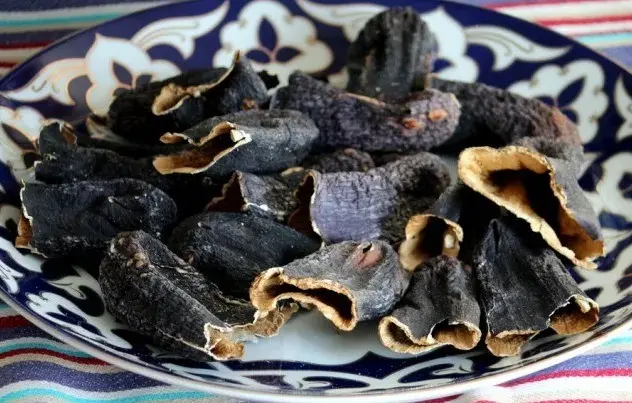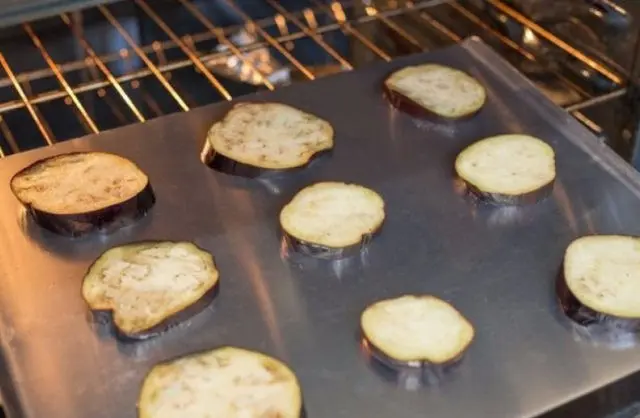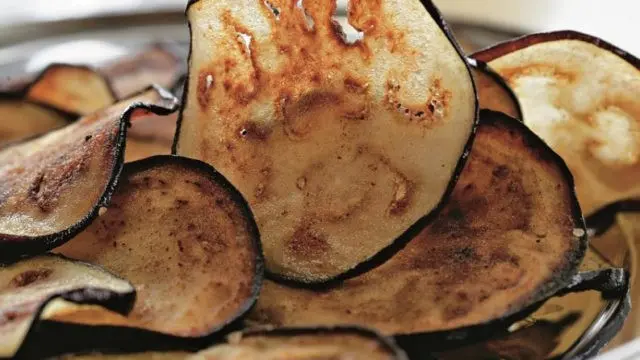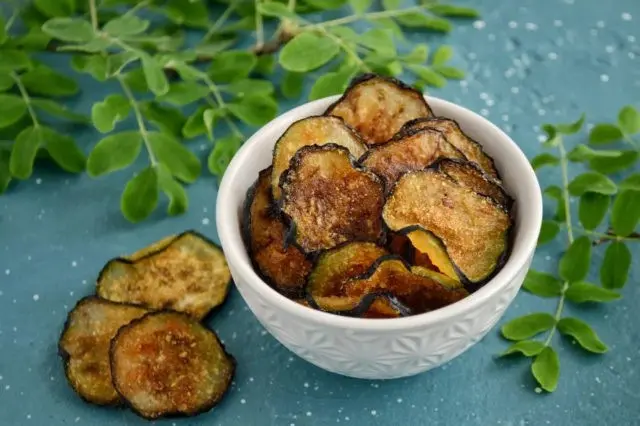Contents
Drying eggplant for the winter is not as difficult as it seems at first glance. There are many ways to stock up on this product until spring. Eggplants have been dried for the winter since ancient times. The tradition of drying the gifts of nature came to us from the eastern countries, where it was first cultivated: the hot, arid climate did not allow long-term storage of food, so the nomads had no choice but to come up with their own way of storage, in the absence of refrigerators.

Dried eggplants take up little space, are light in weight and are easier to store.
Is it possible to dry eggplant for the winter
Products can deteriorate because bacteria begin to multiply in them, the best breeding ground for which is plain water. Vegetables and fruits are 40-80% water, and eggplant is no exception – on average, it contains about 300 g of water. There is a way out: they can be dried, and it is best to start right now – winter is just around the corner.
The drying process of this product often causes difficulties if the hostess does not have special devices: the fruit dehydrates naturally for about a month, while the bright sun should shine outside. Not many cities can boast of such a climate, and not everyone knows how to dry dried fruits for the winter in the oven or microwave.
Selection and preparation of eggplant
The final result is affected not only by the full compliance with the cooking technology, but also by which vegetables were chosen for drying.
To provide the whole family with a delicious delicacy for the winter, you need to go to the market. You should not buy store-bought eggplants: it is likely that they were grown in greenhouses using a huge amount of chemical fertilizers. The fact is that during sublimation, the concentration of such substances can be very large, which will lead to food poisoning.
The fruits themselves must be of the same diameter, have approximately the same length, without skin defects. The firmer the fruit, the easier it is to dry.
It is best to buy eggplants in the fall or at the end of August – it is during this period of time that they begin to ripen, they need to be dried for the winter at the same time.
How to cut eggplant for drying
There are several ways to cut eggplants: the final choice depends on the purpose for which the hostess decided to dry them.
Very beautiful chips are obtained when they are cut into rings: the thickness of each circle should be about 5 mm. If you cut the pieces thinner, then it can become very hard, if thicker, it will not dry out.
If the product goes to a winter vegetable soup, then you can cut the eggplant into 1 × 1 cm cubes, as well as straws of the same thickness.
How to dry eggplant for the winter
The most delicious are those that are dried on clay roofs. They absorb the heat of the sun, dry evenly and turn out crispy, like potato chips – with such a delicacy any winter will seem warmer.
In the oven
It is difficult to dry eggplants for the winter without a dryer, but you can do it with a regular home oven. It is worth immediately warning the inspired housewives that in order to achieve the desired result, you may have to spoil more than one batch of eggplant. Therefore, it is advisable to dry in the beginning in a small amount and select the correct recipe.
The general rules for drying eggplant in the oven are as follows:
- Wash the pieces and dry with paper towels.
- Cut the eggplant in the chosen way and blot again with a paper towel.
- The blanks are salted – salt will draw out additional moisture: this way the process will go faster.
- After the vegetables should “rest” a little: do not be afraid if the pieces start to darken – this is how the oxidative reaction of air and iron, which is part of the eggplant, manifests itself.
- Before putting the eggplant in the oven, you can again remove excess liquid with a towel.
- Many housewives, before drying, advise pouring vegetables with vegetable oil, adding pepper, garlic and other herbs – however, you should not experiment until the technology is perfected.
- The oven is heated to 40-50 degrees. It is worth remembering that home ovens can distort the result by 10-15 degrees. That is why it is important to be patient and use test batches of vegetables: at higher temperatures, the eggplant will cook, and if the degree is below the desired temperature, they will not dry out.
- The blanks must be laid out on parchment or a silicone mat, making sure that the pieces do not touch each other, and left in the oven until completely dry.

The blanks must be salted, this will help to “pull out” additional moisture.
You can drizzle eggplant with extra virgin olive oil, but don’t try this unless you have an oil spray in the kitchen. This is due to the fact that the oily liquid should cover them evenly: if there is more oil in some area, then the piece simply cannot dry evenly.
Very tasty eggplants are obtained if, before drying, sprinkle them with finely chopped garlic: it should be added at the very end, when the eggplants are almost ready. But it also needs time to dry out.
In the dryer
The easiest way to dry eggplant for the winter is in special dryers. This miracle device is inexpensive and is sold in almost every home appliance store. In appearance, it is somewhat reminiscent of a double boiler: it has several plastic tiers on which vegetables and fruits are placed. Moreover, each device is equipped with instructions that describe in detail how to properly dry certain vegetables.

When dried, all vitamins and nutrients are preserved
The general rules for all types of electric dryers are almost the same:
- Eggplant must be washed and dried with a towel.
- Slice.
- Send to the plastic compartments of the dryer.
The smart device will do everything by itself: no need to add salt, as, for example, is the case with the oven.
Outdoors
You can also dry eggplants for the winter on the windowsill – this method is suitable for those who are in no hurry, since vegetables can dry up to a month.
The main rule is to check and control the process daily. If any of the pieces is moldy, you need to immediately isolate it, as well as remove neighboring specimens.
You can dry eggplant right on the street. This method is perfect for residents of the southern regions, in whose regions the bright sun constantly shines, however, they are not immune from rain either: you will have to constantly control the weather and hide dried vegetables in case it starts to rain. You can remove eggplant from the sun only for a couple of hours, otherwise the product may deteriorate.

It is better to dry young fruits, they have less bitterness
But for the residents of the metropolis, this option is completely unsuitable: together with the sun’s rays, vegetables can absorb heavy metals and carcinogens, so you can not dry food on the balcony or with the window open.
You can also dry eggplants for the winter over the battery. To do this, they need to be cut into rings, put on a thread, like beads, and hung over a heater.
In the microwave
It will be possible to dry the little blue ones for the winter in an ordinary microwave, if you find an approach to it. Perhaps, as with drying in the oven, you will have to throw more than one batch of eggplant in the trash. However, there is a high probability that someone will be lucky and get crispy eggplant cubes or chips for the first time.
Microwave drying process:
- Wash vegetables and then dry.
- It is better to cut the eggplant into circles, the cubes will most likely just boil.
- The microwave is turned on at minimum power or set to the “Defrost” mode.Important! Eggplants can not be covered with anything, and it is best to dry on the very tray of the microwave oven.
- Every 2-3 minutes, the pieces need to be turned over and remove excess moisture.
- Drying time depends on the power of the device, but on average it is about one hour.

In the microwave, fragrant and crispy eggplant chips are obtained.
If, instead of drying, eggplants are boiled, they can be added to casseroles, omelets, soups, and cook delicious pancakes.
In order to fry eggplant pancakes you need:
- Take 200 g of baked vegetables.
- Break 1 egg, add salt, spices and a spoonful of flour.
- The mixture is well kneaded and fried in vegetable oil on both sides.
- You can give free rein to your imagination and add onions, grated cheese, cottage cheese – the result will be simply amazing.
How to use dried eggplant
Whatever way the hostess chooses to dry eggplants for the winter, there are only two ways to use them: use them as a finished product or add them to some dish.
To prepare eggplant casserole, you need to take:
- cubed dried eggplant – 300 g;
- potatoes – 300 g;
- carrots – 100 g;
- mayonnaise – 200 g;
- garlic – 1 tooth;
- butter – 50 g;
- cheese “” – 100 g.

Dried vegetables boiled, stewed, baked
Cooking process:
- Vegetables need to be cut, mixed with dried eggplant, seasoned with mayonnaise and butter.
- Transfer to a baking dish and put in the oven for 20 minutes.
- Then sprinkle the casserole with grated cheese and bake for another half hour.
In order to cook soup, you must:
- cubed dried eggplant – 50 g;
- potatoes – 100 g;
- onion – 1 pcs .;
- carrots – 50 g;
- rice – 30 g;
- chicken – 300 g.

Before cooking, the dried product is soaked in hot water.
Cooking process:
- The chicken is cut into small pieces and boiled over low heat for 30-35 minutes.
- Then rice and finely chopped vegetables are added and allowed to boil for another 20 minutes.
- Garlic and fresh herbs can be added to the finished soup.
How to store dried eggplant
If you properly dry eggplants for the winter, then you can enjoy this wonderful product until spring, because it is very easy to save them.
You can save them like this:
- Eggplants dried for chips are stored in glass jars with a tightly screwed lid or in vacuum bags for dried fruits. If there is no such package in the house, you can make it yourself. To do this, you need to take a bag with a zip system, pour vegetables into it, close it tightly, leaving a small hole in which you need to insert a straw for drinks and suck out all the air. Then the package is closed and put away for storage.
- The freezer will perfectly cope with the task of preserving freshness and all the vitamins present. Eggplants just need to be packaged in bags and put in the refrigerator.
- Eggplants dried in cubes are put into a glass jar, olive oil is poured on top, spices and herbs are added. In this way, eggplants can be stored for 2-3 months, and an excellent salad dressing will turn out from the oil filling.

It is better to store dried eggplants in glassware with a lid, in cardboard boxes and cotton bags.
Whatever method of storage the hostess chooses, it is important to follow the general recommendations: it is best to store eggplant in a dry, dark place, protected from moisture and drafts. From time to time, the pieces need to be looked over and moldy removed.
Conclusion
Drying eggplants for the winter is easy, and if you involve the whole family in the process, you can create a new family tradition, this will not only stock up on vitamins for the winter, but also improve relationships. It is very important to store vegetables for future use on time so that they do not deteriorate.









